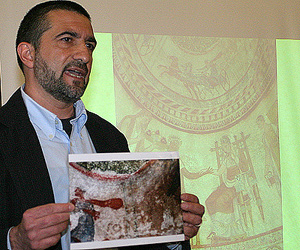I found this article disturbing in the sense that basically racist charges can be levied at a scholar simply because they criticize the scholarly integrity of a work that has an apparent racially-motivated agenda. I have encountered, what have been termed, Afrocentrists myself and have tried to point out to them that, although many of the ancient peoples along the Mediterranean coast were people of color (is that phrase politically correct anymore?) not all ancient people of the entire continent of Africa were sub-Saharan "black" in ethnicity including the Egyptians. I have heard Afrocentrist scholars try to claim Cleopatra, King Tut, Queen Hatsephut, and later, Hannibal, were all "black". In fact I came across some beautiful images of these historical personalities rendered as ethnically black on a website sponsored by Anhauser-Busch. But they overlook historically important facts such as Cleopatra's descent from Ptolemy Soter I, a half-brother of Alexander the Great of Macedon. Ptolemy not only took over the kingdom of Egypt but adopted the intrafamilial marriage practices of pharaonic tradition. Therefore, although its true historians are not sure who her mother was, by tradition she would have been another descendant of the Ptolemy dynasty.
Furthermore, Egyptian tomb paintings distinguish between the reddish skin of "Egyptians" and the black skin of "Nubians". Both King Tut and Queen Hatshepsut are rendered with reddish skin.
In addition, Hannibal was a descendant of a noble Phoenician family that colonized the area around Carthage. It is thought by some that there was some intermarriage with the local Berbers but Berbers are not ethnically "black" either.
There were some very effective Nubian pharaohs, though, that ruled Egypt during the 25th dynasty including King Kashta (745-742 BC),Piankhi (742-715 BC), Shabaka I (715-701 BC), Shakatak (701-689 BC), Taharka (680-664 BC), and Tanutamun (664-650 BC). These pharaohs were ethnically "black". So why do the Afrocentrists feel they must produce inaccurate works about some figures of ancient African history rather than focus on figures that fit their targeted ethnic profile and explore and publicize their lives instead?
As for the Greeks stealing their culture from the Egyptians, I find this a simplistic view of cultural exchange. Trade with other nations always provides the opportunities to exchange ideas and technologies. There is archaeological evidence that there was very early trade between the Minoans and Egyptians. I'm sure there was probably an active exchange of ideas as well as art (fragments of Minoan paintings have been found in Egypt) during this period. But the key word here is "exchange".
Furthermore, to frame Egypt, and through Egypt as Africa, as the source of all ancient knowledge is ludicrous since civilizations in the near East were just as ancient and contributed a great deal to so-called "western" civilizations like the Greeks. One such example is the Greek alphabet that scholars say was developed from the Phoenician alphabet. Another is the chariot that was introduced to the Egyptians by the Hyksos, originally from the near East.
Anyway, here's an abstract from the article I read:
"In 1993, Ms. Lefkowitz, a professor of classics at Wellesley, attended a lecture by Yosef ben-Jochannan, author of "Africa: Mother of Western Civilization." In his lecture, Mr. ben-Jochannan repeated the central claim of his book: that Aristotle had stolen his philosophy from the Egyptians, wholesale, a charge to which Ms. Lefkowitz's husband audibly answered from the audience, "Rubbish." Heated words were exchanged, and Mr. ben-Jochannan's defenders — primarily Ms. Lefkowitz's colleague Anthony Martin, whose courses feted Mr. ben-Jochannan's work — raised an alarm: A Jewish conspiracy against blacks was afoot, they charged, with Ms. Lefkowitz directing the protocols.
At the time of the incident, Ms. Lefkowitz was already on the radar of a number of Jewish-conspiracy theorists. She had reviewed — in the "conservative, Jewish-owned New Republic" (to use Mr. Martin's words) — a two-volume polemic against Greek civilization by Martin Bernal, a sociologist at Cornell. Mr. Bernal's work, "Black Athena," had alleged that classical scholars had not only failed to acknowledge the debt Greece owed Egypt, but that they were actively suppressing that debt (a conspiracy within a conspiracy, in other words). Her review was evidence enough that she, again in Mr. Martin's words, had dug in her heels against "Black progress."
Ms. Lefkowitz had actually gone easy on "Black Athena." And her husband's riposte was quite gentle itself. The charge, remember, was that Aristotle had hopped a boat from Athens, strolled into the library at Alexandria, grabbed a bunch of books, brought them back to Greece, and put his name on them. This is almost so unbelievable that it has to be true — but, alas, it isn't. First, there is no record of Aristotle ever having gone to Egypt. Maybe that evidence was suppressed? Perhaps — but there wasn't even a library in Alexandria for Aristotle to pillage during his lifetime. It wasn't built until at least 297 BCE; Aristotle died in 323 BCE. Even if he had wanted to steal the Egyptians' "Metaphysics," "Poetics," or "Politics," he wouldn't have been able to find them in Alexandria."
If you enjoyed this post, never miss out on future posts by following me by email!













